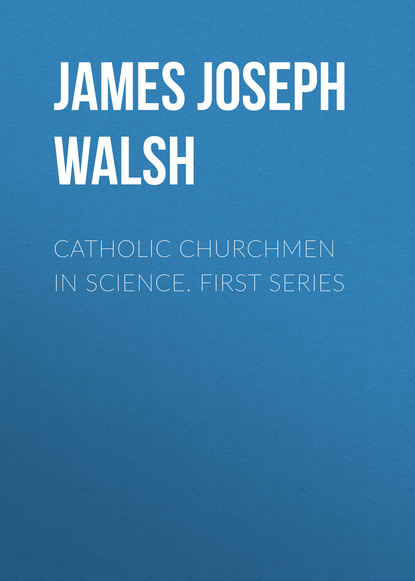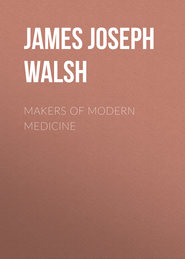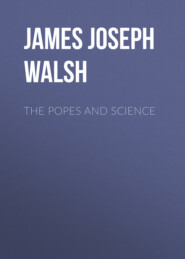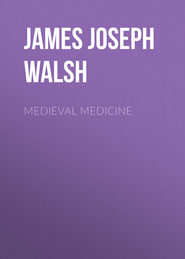По всем вопросам обращайтесь на: info@litportal.ru
(©) 2003-2024.
✖
Catholic Churchmen in Science. First Series
Настройки чтения
Размер шрифта
Высота строк
Поля
It is often a subject for conjecture just how science was studied and taught in centuries before the nineteenth, and just what text-books were employed. A little familiarity with Father Kircher's publications, however, will show that there was plenty of very suitable material for text-books to be found in his works. Under his own direction, what at the present time would be called a text-book of physics, but which at that time was called "Physiologia Experimentalis," was issued, containing all the experimental and demonstrative parts of his various books on chemistry, physics, music, magnetism, and mechanics, as well as acoustics and optics. This formed the groundwork of most text-books of science for a full century afterwards. Indeed, until the beginning of the distinctly modern science of chemistry with the discoveries of Priestley and Lavoisier, there was to be little added of serious import in science.
Perhaps the most commendable feature of Father Kircher's books is the fact that he himself seems never to have considered that he had exhausted a subject. The first work he published was on magnetism. Some twelve years later he returned to the subject, and wrote a more extensive work, containing many improvements over the first volume. The same thing is true of his studies in sound. In 1650, when not quite fifty years of age, he issued his "Musurgia Universalis," a sub-title of which stated that it contains the whole doctrine of sound and the practical and theoretical philosophy of music. A little over twenty years later, however, he published the "Phonurgia Nova," the sub-title of which showed that it was mainly concerned with the experimental demonstration of various truths in acoustics and with the development of the doctrine he had originally stated in the "Musurgia."
It is no wonder that his contemporaries spoke of him as the Doctor centum artium--the teacher of a hundred arts–for there was practically no branch of scientific knowledge in his time in which he was not expert. Scientific visitors to Rome always considered it one of the privileges of their stay in the papal city to have the opportunity to meet Father Kircher, and it was thought a very great honor to be shown through his museum by himself.
Of course, it is difficult for present-day scientists to imagine a man exhausting the whole round of science in this way. Many who have read but little more than the titles of Father Kircher's many books are accordingly prone to speak of him as a mine of information, but without any proper critical judgment. He has succeeded, according to them, in heaping together an immense amount of information, but it is of the most disparate value. There is no doubt that he took account of many things in science that are manifestly absurd. Astrology, for instance, had not, in his time, gone out of fashion entirely, and he refers many events in men's lives to the influence of the stars. He even made rules for astrological predictions, and his astronomical machine for exhibiting the motions of the stars was also meant to be helpful in the construction of astrological tables. It must not be forgotten, however, that in his time the best astronomers, like Tycho Brahe and even Kepler, had not entirely given up the idea of the influence of the stars over man's destiny.
As regards other sciences, there are details of information that may appear quite as superstitious as the belief in astrology. Kircher, for instance, accepted the idea of the possibility of the transmutation of metals. It is to be said, though, that all mankind were convinced of this possibility, and indeed not entirely without reason. All during the nineteenth century scientists believed very firmly in the absolute independence of chemical elements and their utter non-interchangeability. As the result of recent discoveries, however, in which one element has apparently been observed giving rise to another, much of this doctrine has come to be considered as improbable, and now the idea of possible transmutation of metals and other chemical elements into one another appears not so absurd as it was half a century ago.
Any one who will take up a text-book of science of a century ago will find in it many glaring absurdities. It will seem almost impossible that a scientific thinker, in his right senses, could have accepted some of the propositions that are calmly set down as absolute truths. Every generation has made itself ridiculous by knowing many things "that are not so," and even ours is no exception. Father Kircher was not outside this rule, though he was ahead of his generation in the critical faculty that enabled him to eliminate many falsities and to illuminate half-truths in the science of his day.
Undoubtedly the most interesting of Father Kircher's scientific books is his work On the Pest, with some considerations on its origin, mode of distribution, and treatment, which about the middle of the seventeenth century gathered together all the medical theories of the times as to the causation of contagious disease, discussed them with critical judgment and reached conclusions which anticipate much of what is most modern in our present-day medicine. It is this work of Father Kircher's that is now most often referred to, and very deservedly so, because it is one of the classics which represents a landmark in knowledge for all time. It merits a place beside such books as Harvey on the Circulation of Blood, or even Vesalius on Human Anatomy. As we have seen, it is now quoted from by our best recent authorities who attempt seriously to trace the history of the microbic theory of disease, and its conclusions are the result of logical processes and not the mere chance lighting upon truth of a mind that had the theories of the time before it. In it Father Kircher's genius is best exhibited. It has the faults of his too ready credibility; and his desire to discuss all possible phases of the question, even those which are now manifestly absurd, has led him into what prove to be useless digressions. But on the whole it represents very well the first great example of the application of the principle of inductive science to modern medicine. All the known facts and observations are collected and discussed, and then the conclusions are suggested.
It is very interesting to trace the development of Father Kircher's ideas with regard to the origin, causation, and communication of disease, because in many points he so clearly anticipates medical knowledge that has only come to be definitely accepted in very recent times. It has often been pointed out that Sir Robert Boyle declared that the processes of fermentation and those which brought about infectious disease, were probably of similar nature, and that the scientist who solved the problem of the cause of fermentation would throw great light on the origin of these diseases. This prophetic remark was absolutely verified when Pasteur, a chemist who had solved the problem of fermentation, also solved the weightier questions connected with human diseases. Before even Boyle, however, Father Kircher had expressed his opinion that disease processes were similar to those of putrefaction. He considered that putrefaction was due to the presence of certain corpuscula, as he called them, and these he said were also probably active in the causation of infectious disease.
He was not sure whether or not these corpuscula were living, in the sense that they could multiply of themselves. He considered, however, that this was very probable. As to their distribution, he is especially happy in his anticipations of modern medical progress. While he considered it very possible that they were carried through the air, he gives it as his deliberate opinion that living things were the most frequent agents for the distribution of the corpuscles of disease. He is sure that they are carried by flies, for instance, and that they may be inoculated by the stings of such insects as fleas or mosquitoes. He even gives some examples that he knew of in which this was demonstrated. Still more striking is his insistence on the fact that such a contagious disease as pest may be carried by cats and dogs and other domestic animals. The cat seemed to him to be associated with special danger in this matter, and he gives an example of a nunnery which had carefully protected itself against possible infection, but had allowed a cat to come in, with the result that some cases of the disease developed.
An interesting bit of discussion is to be found in the chapter in which Father Kircher takes up the consideration of the problem whether infectious disease can ever be produced by the imagination. He is speaking particularly of the pest, but there is more than a suspicion that under the name pest came at times of epidemics many of our modern contagious diseases. Father Kircher says that there is no doubt that worry plays an important role in predisposing persons to take the disease. He does not consider, however, that it can originate of itself, or be engendered in the person without contact with some previous case of pest. With regard to the question of predisposition he is very modern. He points out that many persons do not take the disease, because evidently of some protective quality which they possess. He is sure, too, that the best possible protection comes from keeping in good, general health.
A curious suggestion is that with regard to the grave-diggers and undertakers. It has often been noted in Italy, so Father Kircher asserts, that these individuals as a rule did not succumb to the disease, notwithstanding their extreme exposure, when the majority of the population were suffering from it. Toward the end of the epidemic, however, at the time when the townspeople were beginning to rejoice over its practical disappearance, it was not unusual to have these caretakers of the dead brought down with the disease–often, too, in fatal form. Father Kircher considers that only strong and healthy individuals would take up such an occupation. That the satisfaction of accomplishing a large amount of work and making money kept them in good health. Later on, however, as the result of overwork during the time of the epidemic and also of discouragement because they saw the end of prosperous times for them, they became predisposed to the disease and then fell victims.
With regard to the prevention of the pest in individual cases, Father Kircher has some very sensible remarks. He says that physicians as a rule depend on certain medicinal protectives or on amulets which they carry. The amulets he considers to be merely superstitious. The sweet-smelling substances that are sometimes employed are probably without any preventive action. Certain physicians employed a prophylactic remedy made up of very many substances. This is what in modern days we would be apt to call a "gunshot prescription." It contained so many ingredients that it was hoped that some one of them would hit the right spot and prove effective. Father Kircher has another name for it. We do not know whether it is original with him, but in any case it is worth while remembering. He calls it a "calendar prescription," because when written it resembled a list of the days of the month.
His opinion of this "calendar prescription" is not very high. It seems to him that if one ingredient did good, most of the others would be almost as sure to do harm. The main factor in prophylaxis to his mind was to keep in normal health, and this seemed not quite compatible with frequent recourse to a prescription containing so many drugs that were almost sure to have no good effect and might have an ill effect. It is all the more interesting to find these common-sense views because ordinarily Father Kircher is set down as one who accepted most of the traditions of his time without inquiring very deeply into their origin or truth, simply reporting them out of the fulness of his rather pedantic information. In most cases it will be found, however, that, like Herodotus, reporting the curious things that had been told him in his travels, he is very careful to state what are his own opinions and what he owes to others and gives place to, though without attaching much credence to them.
It must not be forgotten that his great contemporaries, Von Helmont and Paracelsus, were not free from many of the curious scientific superstitions of their time, though they had, like him, in many respects the true scientific spirit. Von Helmont, for instance, was a firm believer in the doctrine of spontaneous generation, and even went so far as to consider that it had its application to animals of rather high order. For instance, one of his works contains a rather famous prescription to bring about the spontaneous generation of mice. What was needed was a jar of meal kept in a dark corner covered by some soiled linen. After three weeks these elements would be found to have bred mice. Too much must not be expected, then, of Kircher in the matter of crediting supposedly scientific traditions.
It may seem surprising that Father Kircher's book did not produce a greater impression upon the medical research work and teaching of the day and lead to an earlier development of microbiology. Unfortunately, however, the instruments of precision necessary for such a study were not then at hand, and the gradual loss of prestige of the book is therefore readily to be understood. The explanation of this delay in the development of science is very well put by Crookshank, who is the professor of comparative pathology and bacteriology at King's College, London, and one of the acknowledged authorities on these subjects in the medical world. Professor Crookshank says, at the beginning of the first chapter of his text-book on bacteriology, in which he traces the origin of the science, that the first attempt to demonstrate the existence of the contagium vivum dates back almost to the discovery of the microscope:–[10 - A Text-Book of Bacteriology. Including the Etiology and Prevention of Infectious Diseases By Edgar M. Crookshank. Fourth Edition London, 1896]
Athanasius Kircher nearly two and a half centuries ago expressed his belief that there were definite micro-organisms to which diseases were attributable. The microscope had revealed that all decomposing substances swarmed with countless micro-organisms which were invisible to the naked eye, and Kircher sought for similar organisms in disease, which he considered might be due to their agency. The microscopes which he describes obviously could not admit of the possibility of studying or even detecting the micro-organisms which are now known to be associated with certain diseases; and it is not surprising that his teaching did not at the time gain much attention. They were destined, however, to receive a great impetus from the discoveries which emanated not long after from the father of microscopy, Leeuwenhoek.
This reference to Kircher's work, however, shows that more cordial appreciation of his scientific genius has come in our day, and it seems not unlikely that in the progress of more accurate and detailed knowledge of scientific origins his reputation will grow as it deserves. With that doubtless will come a better understanding of the true attitude of the scholars of the time–so many of whom were churchmen–to so-called physical science in contradistinction to philosophy, in which of course they had always been profoundly interested. The work done by Kircher could never have been accomplished but for the sympathetic interest of those who are falsely supposed to have been bitterly opposed to all progress in the natural sciences, but whose opposition was really limited to theoretic phases of scientific inquiry that threatened, as has scientific theory so often since, to prove directly contradictory to revealed truth.
VI.
BISHOP STENSEN: ANATOMIST AND FATHER OF GEOLOGY
God makes sages and saints that they may be fountain-heads of wisdom and virtue for all who yearn and aspire: and whoever has superior knowledge or ability is thereby committed to more effectual and unselfish service of his fellow-men. If the love of fame be but an infirmity of noble souls, the craving of professional reputation is but conceit and vanity. To be of help, and to be of help not merely to animals, but to immortal, pure, loving spirits this is the noblest earthly fate.–BISHOP SPALDING: The Physician's Calling and Education.
VI.
BISHOP STENSEN, ANATOMIST AND FATHER OF GEOLOGY
In the sketch of the life of Father Athanasius Kircher, the distinguished Jesuit scientist, mathematician, and Orientalist, I called attention to the fact that, at the very time when Galileo was tried and condemned at Rome, because of his abuse of Scripture for the demonstration of scientific thesis, a condemnation which has been often since proclaimed to be due to the Church's intolerant opposition to science, the ecclesiastical authorities at Rome invited Father Kircher, who was at that time teaching mathematics in Germany, to come to Rome, and during the next half-century encouraged him in every way in the cultivation of all the physical sciences of the times. It was to popes and cardinals, as well as to influential members of his own order of the Jesuits, that Father Kircher owed his opportunities for the foundation of a complete and magnificent museum, illustrating many phases of natural science–the first of its kind in the world, and which yet continues to be one of the noteworthy collections.
During the decade in which the condemnation of Galileo and the invitation of Father Kircher to Rome took place, there was born, at Copenhagen, a man whose career of distinction in science was to prove even more effectively than that of Kircher, if possible, that there was no opposition in ecclesiastical circles in Italy, during this century, to the development of natural science even in departments in respect to which the Church has, over and over again, been said to be specially intolerant. This scientist was Nicholas Stensen, the discoverer of the duct of the parotid gland, which conducts saliva into the mouth, and the founder, in the truest sense of the word, of the modern science of geology. Stensen's discovery of the duct which has since borne his name was due to no mere accident; for he was one of the really great anatomists of all time, and one distinguished particularly for his powers of original observation and investigation. To have the two distinctions, then, of a leader in anatomy and a founder in geology, stamps him as one of the supreme scientific geniuses of all time, a man not only of a fruitfully inquiring disposition of mind, but also one who possessed a very definite realization of how important for the cause of scientific truth is the necessity of testing all ideas with regard to things physical, by actual observations of nature and by drawing conclusions not wider than the observed facts.
Notwithstanding this characteristically scientific temper of mind, which, according to most modern ideas, at least, would seem to be sure to lead him away from religious truth, Stensen at the very height of his career as a scientist, while studying anatomy and geology in Italy, became a convert from Lutheranism, in which he had been born, to Catholicity, and thereafter made it one of the prime objects of his life to bring as many others as possible of the separated brethren into the fold of the Church. When he accepted the professorship of anatomy at the University of Copenhagen, it was with the definite idea that he might be able to use the influence of his position to make people realize how much of religious truth there was in the old Church from which they had been separated in the preceding century. After a time, however, his zeal led him to resign his position, and ask to be made a priest, in order that he might be able more effectively to fulfil what he now considered the main purpose of his life, the winning of souls to the Church. As, since his conversion, he had given every evidence of the most sincere piety and humble simplicity, his desires were granted. His book on geology, however, was partly written during the very time when he was preparing for sacred orders, and was warmly welcomed by all his Catholic friends. After spending some time as a missionary, and attracting a great deal of attention by his devout life and by the many friends and converts he succeeded in making, the recently converted Duke of Hanover asked that the zealous Danish convert should be made bishop of his capital city. This request was immediately granted, and Stensen spent several years in the hardest missionary labor in his new field. As a matter of fact, his labors proved too much for his rather delicate constitution, and he died at the comparatively early age of forty-eight. The visitor to the University of Copenhagen marvels to find among the portraits of her professors of anatomy one in the robes of a Roman Catholic bishop. This is Stensen. In 1881, when the International Geographical Congress met at Bologna, it adjourned at the end of the session to Florence to unveil a bust of Stensen, over his tomb there. Here evidently is a man whose life is well worth studying, because of all that it means for the history of his time.
Nicholas Stensen–or, as he is often called, Steno, because this is the Latin form of his name, and Latin was practically exclusively used, during his age, in scientific circles all over Europe–was born 20 January, 1638, in Copenhagen. His father died while he was comparatively young, and his mother married again, both her husbands being goldsmiths in high repute for their skill, and both of them in rather well-to-do circumstances. His early education was obtained at Copenhagen, and the results displayed in his attainments show how well it must have been conducted. Later in life he spoke and wrote Latin very fluently and had, besides, a very thorough knowledge of Greek and of Hebrew. Of the modern languages, German, French, Italian, and Low Dutch he knew very well, mainly from residence in the various countries in which they are spoken. A more unusual attainment at that time, and one showing the ardor of his thirst for knowledge, was an acquaintance with English. In early life he was especially fond of mathematics and, indeed, it was almost by accident that this did not become his chosen field of educational development.
At eighteen he became a student of the University of Copenhagen, and after some preliminary studies in philosophy and philology devoted himself mainly to medicine. At this time the Danish University was especially distinguished for its work in anatomy. The famous family of Bartholini, who had for several generations been teaching there, had proved a copious source of inspiration for the students in their department, and as a consequence original investigation of a high order, with enthusiasm for the development of anatomical science, had become the rule. The external situation was not favorable to learning, for Denmark was engaged in harassing and costly wars during a considerable portion of the seventeenth century; yet the work accomplished here was, undoubtedly, some of the best in Europe. Young Stensen had the advantage of having Thomas Bartholini as his preceptor, and soon, because of his enthusiasm for science, as friend and father.
Stensen had been at the University scarcely two years when the city of Copenhagen was besieged by the Swedes. Professor Lutz, of the University of St. Louis, who has recently written an article on Stensen, which appeared in the Medical Library and Historical Journal for July, 1904, says of this period:
A regiment of students numbering two hundred and sixty-six, called "the black coats" on account of their dark clothes, was formed for the defence of the city; upon its roster we find the name of young Steno. During the day they were at work mending the ramparts, and the nights were spent in repelling the attacks of the enemy. In the course of this long siege, the city was compelled to cope with a more formidable enemy than the Swedes–famine with all its horrors–before relief came in the shape of provisions and reinforcements furnished by the Dutch fleet. Throughout these turbulent days the student soldiers rendered valuable services to their country, and though it be true that "inter arma silent musae"–"the war gods do not favor the muses"–it appears nevertheless that Steno attended the lectures and dissections which were conducted by the teachers in the intervals when the student were not on duty.
After some three years spent at the University of Copenhagen, Stensen, as was the custom of the times, went to pursue his post-graduate studies in a foreign university. Bartholini furnished him with a letter of recommendation to Professor Blasius, who was teaching anatomy at Amsterdam in Holland. Amsterdam had become famous during the seventeenth century for the very practical character of its anatomical teaching. As the result of the cordial commendation of Bartholini, Stensen became an inmate of the house of Professor Blasius, and was given special opportunities to pursue his anatomical studies for himself. He had been but a very short time at Amsterdam, when he made the discovery to which his name has ever since been attached, that of the duct of the parotid gland. Stensen's discovery was made while he was dissecting the head of a sheep. He found shortly afterwards, however, that the canal could be demonstrated to exist in the dog, though it was not so large a structure. Blasius seems to have been rather annoyed at the fact that a student, just beginning work with him, should make so important a discovery, and wished to claim the honor of it for himself. There is no doubt, however, now, notwithstanding the discussion over the priority of the discovery which took place at the time, that Stensen was the first to make this important observation.
Not long before, Wharton, an English observer, had demonstrated the existence of a canal leading from the submaxillary gland into the mouth. This might have been expected to lead to the discovery of other glandular ducts, but so far had not. As a matter of fact, the function of the parotid gland was not well understood at this time. During the discussion as to priority of discovery, Steno pointed out one fact which he very properly considers as the most conclusive proof that Blasius did not discover the duct of the gland. He says: "Blasius shows plainly in his treatise 'De Medicina Generali' that he has never sought for the duct, for he does not assign to it either the proper point of beginning or ending, and assigns to the parotid gland itself so unworthy a function as that of furnishing warmth to the ear, so that if I were not perfectly sure of having once shown him the duct myself, I should be tempted to say that he had never seen it."
Bartholini settled the controversy, and at the same time removed any discouragement that might have arisen in his young pupil's mind, by writing to him:–
Your assiduity in investigating the secrets of the human body, as well as your fortunate discoveries, are highly praised by the learned of your country. The fatherland congratulates itself upon such a citizen, I upon such a pupil, through whose efforts anatomy makes daily progress, and our lympathic vessels are traced out more and more. You divide honors with Wharton, since you have added to his internal duct an external one, and have thereby discovered the sources of the saliva concerning which many have hitherto dreamed much, but which no one has (permit the expression) pointed out with the finger. Continue, my Steno, to follow the path to immortal glory which true anatomy holds out to you.
Under the stimulus of such encouragement, it is no wonder that Stensen continued his original work with eminent success. He published an extensive article on the glands of the eye and the vessels of the nose.
Bartholini wrote to him again: "Your fame is growing from day to day, for your pen and your sharp eye know no rest." Later he wrote again: "You may count upon the favor of the king as well as upon the applause of the learned." After three years at the University of Amsterdam, Steno returned to Copenhagen, where he published his "Anatomical Observations Concerning the Muscles and Glands." It was in this book that he announced his persuasion that the heart was a muscle. As he said himself, "the heart has been considered the seat of natural warmth, the throne of the soul; but if you examine it more closely, it turns out to be nothing but a muscle. The men of the past would not have been so grossly mistaken with regard to it, had they not preferred their imaginary theories to the results of the simple observation of nature." It is easy to understand that this observation created a very great sensation. It had much to do with overthrowing certain theoretic systems of medicine, and nearly a century later the distinguished physiologist, Haller, did not hesitate to proclaim the volume in which it occurs, as a "golden book."
Stensen's studies in anatomy stamp him as an original genius of a high order, and this is all the more remarkable because his career occurs just in those years when there were distinguished discoverers in anatomy in every country in Europe. When Stensen began his work in anatomy, Harvey was still alive. The elder Bartholini, the first who ever established an anatomical museum, was another of his contemporaries. Among the names of distinguished anatomists with whom Stensen was brought intimately in contact during the course of his studies in Holland, France and Italy are those of Swammerdam, Van Horne, and Malpighi. There is no doubt that his intercourse with such men sharpened his own intellectual activity, and increased his enthusiasm for original investigation in contradistinction to the mere accumulation of information.
His contemporaries, indeed, exhausted most of the adjectives of the Latin language in trying to express their appreciation of his acuity of observation. He was spoken of as oculatissimus--that is, as being all eyes, subtilissimus, acutissimus, sagacissimus in his knowledge of the human body, and as the most perspicacious anatomist of the time. Leibnitz and Haller were in accord in considering him one of the greatest of anatomists. In later years this admiration for Stensen's genius has not been less enthusiastically expressed. Haeser, in his "History of Medicine," the third edition of which appeared at Jena in 1879, says: "Among the greatest anatomists of the seventeenth century belongs Nicholas Steno, the most distinguished pupil of Thomas Bartholini. Steno was rightly considered in his own time as one of the greatest of anatomical discoverers. There is scarcely any part of the human body the knowledge of which was not rendered more complete by his investigations."
The most valuable discovery made by Stensen was undoubtedly that the heart is a muscle. It must not be forgotten that in his time, Harvey's discovery of the circulation of the blood was not yet generally accepted; indeed, there were many who considered the theory (as they called it) of the English investigator as one of the passing fads of medicine. Two significant discoveries, made after Harvey, served, however, to establish the theory of the circulation of the blood on a firm basis and to make it a definite medical doctrine. The most important of these was Malpighi's discovery that the capillaries–that is, the minute vessels at the end of the arterial tree on the surface of the body and in various organs–served as the direct connexion between the veins and the arteries. This demonstrated just how the blood passed from the arterial to the venous system. Scarcely less important, however, for the confirmation of Harvey's teaching was Stensen's demonstration of the muscular character of the tissue of the heart.
Some of his observations upon muscles are extremely interesting, and, though he made many mistakes in explaining their function, he added not a little to the anatomical and physiological knowledge of the time in their regard. He seems to have been one of the first to recognize the fact that in the higher animals the heart may continue to beat for a considerable time after the animal is apparently dead; and, indeed, that by irritation of the removed heart, voluntary contractions may be brought about which will continue spontaneously for some moments.
With regard to the objections made by some, that such studies as these upon muscles could scarcely be expected to produce any direct result for the treatment of disease, or in the ordinary practice of medicine, Stensen said in reply that it is only on the basis of the anatomical, physiological, and pathological observation that progress in medicine is to be looked for. In spite, then, of the discouragement of the many, who look always for immediate practical results, Stensen continued his investigation, and even proposed to make an extended study of the mechanism of the muscular action.
In the meantime, however, there had gradually been coming into his life another element which was to prove more absorbing than even his zeal for scientific discovery. It is this which constitutes the essential index of the man's character and has been sadly misunderstood by many of his biographers.
Sir Michael Foster, of Cambridge, England, in his "Lectures on the History of Physiology," originally delivered as the Lane Lectures at Cooper Medical College, San Francisco, said:–
While thus engaged, still working at physiology, Stensen turned his versatile mind to other problems, as well as to those of comparative anatomy, and especially to those of the infant, indeed hardly as yet born, science of geology. His work "De solido intra solidum" is thought by geologists to be a brilliant effort toward the beginning of their science
In 1672 he returned for a while to his native city of Copenhagen, but within two years he was back again at Florence; and then there came to him, while as yet a young man of some thirty-six summers, a sudden and profound change in his life.
In his early days he had heard much, too much perhaps, of the doctrines of Luther. Probably he had been repelled by the austere devotion which ruled the paternal roof. And, as his answer to Bossuet shows, his university life and studies, his intercourse with the active intellects of many lands, and his passion for inquiry into natural knowledge, had freed him from passive obedience to dogma. He doubtless, as did many others of his time, looked upon himself as one of the enlightened, as one raised above the barren theological questions which were moving the minds of lesser men
Yet it was out of this sceptical state of mind, that life in Italy and intimate contact with ecclesiastics and religious, so often said to be likely not to have any such effect, brought this acute scientific mind into the Catholic Church. Nor did he become merely a formal adherent, but an ardent believer, and then an enthusiastic proselytizer. One American writer of a history of medicine, in his utter failure to comprehend or sympathize with the change that came over Stensen, speaks of him as having become at the end of his life a mere "peripatetic converter of heretics." This phase of Stensen's life has, however, as ample significance as any that preceded it.
Steno's expectations of the professorship of anatomy at Copenhagen were disappointed, but the appointment went to Jacobson, whose work indeed is scarcely less distinguished than that of his unsuccessful rival. The next few years Stensen passed in Paris, where he was assiduous in making dissections, and where he attracted much attention; and then, somewhat later, in Italy; in 1665 and 1666 he was in Rome. Thence he went to Florence, in order to perfect himself in Italian. The next few years he spent in this city, having received the appointment of body physician to the Grand Duke, as well as an appointment of visiting physician, as we would call it now, to the Hospital of Santa Maria Nuova.
It was while at Florence that the whole current of Stensen's life was changed by his conversion to Catholicity. His position as physician to the Hospital of Santa Maria Nuova brought him frequently into the apothecary shop attached to the hospital. As a result he came to know very well the religious in charge of the department, Sister Maria Flavia, the daughter of a well-known Tuscan family. At this time she had been for some thirty-five years a nun. Before long she learned that the distinguished young physician, at this time scarcely thirty years of age, who was such a pleasant gentleman in all his ways, was a Lutheran. She began, as she told afterwards, first by prayer, and then by friendly suggestions, to attempt to win him to the Catholic Church. Stensen, who seems already to have been well-disposed toward the Church, and who had always been known for a wonderful purity of heart and simplicity of character, listened very willingly to the naive words of the old religious, who might very well have been his mother.
Many years later, by the command of her confessor, the good Sister related the detailed story of his conversion. She began very simply by telling him one day that if he did not accept the true Catholic faith, he would surely go to hell. He listened to this without any impatience, and she said it a number of other times, half jokingly perhaps, but much more than half in earnest. As he listened so kindly, she said to him one day that he must pray every day to God to let him know the truth. This he promised to do and, as she found out from his servant (what is it these nuns do not find out?) he did pray every evening. One day, while he was in the apothecary shop, the Angelus bell rang, and she asked him to say the Angelus. He was perfectly willing to say the first part of the Hail Mary, but he did not want to say the second part, as he did not believe in the invocation of the Blessed Virgin and the saints. Then she asked him to visit the Church of the Blessed Virgin, the Santissima Nunziata, which he did. After this she suggested to him that he should abstain from meat on Fridays and Saturdays, which he promised to do, and which the good nun found out once more from his servant, he actually did do. And then the religious thought it was time to suggest that he should consult a clergyman, and his conversion was not long delayed.
Young Stensen seems to have been the object of solicitude on the part of a number of the good, elderly women with whom he was brought in contact. He discussed with Signora Arnolfini the great difficulty he had in believing the mystery of the Eucharist. Another good woman, the Signora Lavinia Felice, seeing how interested he was in things Catholic, succeeded in bringing him to the notice of a prominent Jesuit in Florence. As his friend, Sister Maria Flavia, had recommended the same Father to him, he followed the advice all the more readily, and it was not long before his last doubts were solved.











